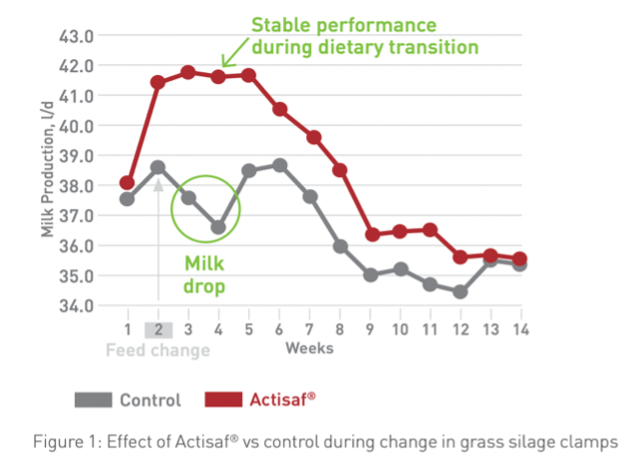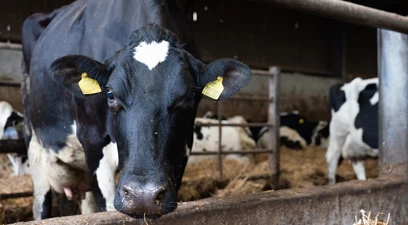Feeding for milk and butterfats: optimising the rumen microbes
Published: 14 March 2025
Many dairy herds throughout the UK are returning to the grazing platform, taking advantage of such an excellent, cost-effective source of energy and protein. However, as the season gets underway, it’s important to be mindful of its challenges.
“Careful management ensures cows get the most from grazing, and this starts with understanding the role that the rumen plays,” says Kevin Doyle, Technical Manager for Phileo by Lesaffre UK & Ireland.
The rumen microbes and grass utilisation
Rumen microbes play a crucial role in breaking down a cow’s feed, but their efficiency varies depending on factors like feed consistency, nutrient balance, and even stress levels. In fact, studies have found that the most efficient cows required 2.6kg less dry matter per day than others to produce the same amount of milk.
Cows convert feed into milk at varying levels of efficiency, and research is now suggesting that more than 50% of the variation between cows’ production performance can be attributed to the make-up of their rumen microbiome.
“As these microbes drive fermentation, the rumen supplies most of the cow’s energy and nutrients,” Kevin explains. “By supporting key microbes, we can enhance this process and maximise feed efficiency – regardless of the production system, lactation stage or season. Think of the rumen as a car engine: a vital power source that needs regular care and maintenance to keep the whole system running smoothly.”
The grazing season presents a few distinct challenges that farmers should be aware of to ensure good rumen function and minimise any negative impacts on yield and milk solids.
Challenge 1: Turnout
While rumen microbial communities are highly adaptable, a different mix of microbes is required for every diet to optimise feed digestion and its conversion into milk. Turnout to grass represents a significant change for the cow and the rumen microbes need around three weeks to adjust. To help with a smoother transition start with 2-3 hours grazing per day (around 5kg DMI) and increase over this time period.
Challenge 2: Balancing grazed grass nutritionally
Grazed grass is one of the highest quality and cheapest feeds on farm, and maximising its utilisation is paramount to a profitable business. However, during prolonged wet weather or lower availability, cows cannot physically consume enough grass to meet their nutritional requirements. This is especially true for spring block calvers who are in early lactation and at increased risk of metabolic issues like sub-clinical ketosis and reduced peak milk yield.
Grass quality varies with weather and time, making nutrient intake unpredictable. While well-managed grass is rich in energy and protein, it often lacks structural fibre with fluctuating dry matter and sugar levels, which can lead to inconsistent energy intake. Grass also often contains high levels of rumen degradable protein, which can require a significant amount of energy to excrete if not balanced with matching carbohydrates. This is particularly relevant for spring block cows in early lactation.
“It’s important that we get the balance right between grass utilisation, encouraging DMI, providing the nutrients that grass is lacking, achieving peak milk yield and ensuring metabolic health for the breeding period,” continues Kevin.
“To balance the diet, a compound feed can provide essential vitamins, minerals, and nutrients not available elsewhere. Aim for 14-16% crude protein, highly digestible fibre, a well-balanced cereal mix and bypass protein.”
Challenge 3: Managing rumen function and milk solids
When farmers see a drop in butterfats around April, what they’re really seeing is a disruption to the rumen microbial population. While a small drop in fat % can be considered normal during the second round of grazing, negative effects can be mitigated if cows and their diets are managed appropriately.
Lush, leafy swards boost milk production and proteins, but they are also high in rapidly fermented sugars and low in fibre. This can lower rumen pH, increasing the risk of sub-acute rumen acidosis (SARA), which affects rumen efficiency, herd performance, and fertility. Because the digestion of fibre is a significant part of butterfat synthesis, SARA also reduces milk solids yield, directly impacting milk price for many.
The presence of poly unsaturated fatty acids (PUFAs) in grass at certain periods can also suppress butterfats. Low rumen pH amplifies the fat-suppressive properties of PUFAs found in stressed grass plants, which also reduces butterfat levels
Watch out for Cow Signals
Farmers can monitor their herd’s rumen function by looking out for a few simple warning signs – or CowSignals – at this time of year:
- Poor rumen fill: check 3-4 hours after morning milking
- Cudding rates: >65% should be lying down cudding 2-3 hrs after eating unless they are drinking or grazing
- Dung consistency: is dung bubbly, loose; does it contain undigested fibre particles?
- Body condition score: weight loss during early lactation period should be less than 0.5 BCS
- Milk quality – Ensure the bufferfat to protein ratio stays around 1.2 to 1. Drops of 0.3% or more in 1 week is a sign of SARA or poor rumen function.
Getting a return on feeding for milk yield
It has been a while since the milk to feed price ratio has looked so positive – above 1:1.4 in most cases - meaning feeding for higher milk yields looks like a viable proposition for many.
“However, it’s important to note that feed response of grazing cows is not a flat line because at higher levels of feeding, cows will reduce their grass DMI in favour of concentrates,” continues Kevin. “Genetics and cow type also play a role in determining the response to feeding and return on investment.
“Additionally, if your milk price is affected by milk solids, maximising fat and protein from grass is still extremely important in driving milk price and profit per cow.
A typical Holstein or British Friesian cow can produce a litre of milk from 0.45 kg of a high quality, balanced feed. With an average base milk price of 43-49ppl (4.1% butterfat, 3.35% protein) and high spec feed costing £340/tonne on average, this means that it will pay this spring to feed for additional milk.
Higher genetic merit herds may produce up to 2-2.2 L/kg of feed at higher feeding rates like 0.45kg/L. Based on a response of 2L per kg fed, 47p/ litre milk price & £340/tonne feed price, 6kg of concentrate has the potential to make a profit of £3.60/cow per day!
“For certain contracts, if we can improve fat – or prevent it dropping by 0.1-0.2% – this equates to an additional 0.6-1.2ppl or 18-36p/cow giving 30 litres,” Kevin explains.
“By increasing the energy supply to the cow through feeding, we can support higher milk protein levels relative to genetic potential, which is worth 0.54ppl for every 0.1% increase over base and further adds to returns.
Support rumen function and milk solids yield with Actisaf®
Adding Actisaf® Sc 47 live yeast to compound feed can help reduce the risk of SARA (and subsequent drop in milk solids) by stabilising rumen function and pH, supporting performance and cow comfort.
University of Nottingham research found this feeding rate to increase feed efficiency by 5.5%, delivering 2.8kg more energy-corrected milk with no extra feed intake. Over a 305-day lactation, this could mean 580L more milk per cow, lowering costs by over 1ppl.

Even in herds without SARA, Actisaf improves rumen efficiency and enhances digestion when included at a rate of 1-2kg/tonne of compound feed (10g/head/day). This leads to more nutrients being extracted from feed and forage to boost milk and milk solids yield. Actisaf® has also been proven to aid the rumen microbes in adapting between diets, which is critical as herds are being turned out to grass.
Related Tech Info

Heat stress is not only a challenge faced by milk producers in warmer climates - cows are also susceptible to it here in the ...

A focus on management and nutrition during the 3 weeks pre- and post-calving makes all the difference to performance in the n...

Actisaf® Sc47 live yeast is a powerful tool to help the most demanding period in the lactation cycle, from the transition per...
